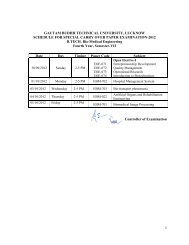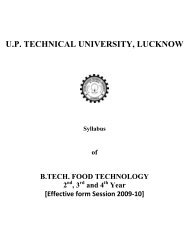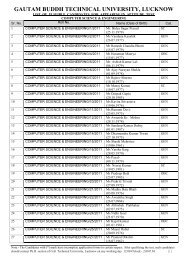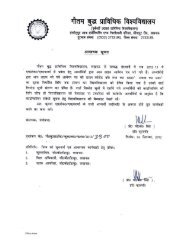NOTE MASTER OF BUSINESS ADMINISTRATION (MBA): The ...
NOTE MASTER OF BUSINESS ADMINISTRATION (MBA): The ...
NOTE MASTER OF BUSINESS ADMINISTRATION (MBA): The ...
You also want an ePaper? Increase the reach of your titles
YUMPU automatically turns print PDFs into web optimized ePapers that Google loves.
Macroeconomics: National Income-concepts and various methods of its measurement. Inflation: theories. Introduction to<br />
business cycles<br />
SUGGESTED READINGS<br />
1) Peterson HC and Lewis- Managerial Economics , 3 rd , 1995 (Himalaya)<br />
2) Trivedi- Managerial Economics (Tata McGraw-Hill, 2002)<br />
3) Dwivedi- Managerial Economics (Vikas, 6 th edition), 2001.<br />
4) Gupta- Managerial Economics Tata McGraw-Hill, 1990, 8 th ed.<br />
5) Koutsyannis A- Modern Microeconomics (Macmillan), 1979, 6 th ed.<br />
6) Maheswari and Gupta- Managerial Economics (Sultan Chand)<br />
7) Mote V et al- Managerial Economics Tata McGraw-Hill, 2001.<br />
8) Savage C I and Small JR- Introduction to Managerial Economics (Hutchinson, 1979)<br />
<strong>MBA</strong> 115: <strong>BUSINESS</strong> STATISTICS Max. Hours: 40<br />
Unit I (8 Sessions)<br />
Role of statistics: Application of inferential statistics in managerial decision-making; Measures of central tendency: mean,<br />
median and mode and their implications; Measures of Dispersion: range, skewness, standard deviation and mean deviation<br />
Unit II (6 Sessions)<br />
Time series analysis: Concept, and secular trend; Seasonal variation; Cyclical variation and Irregular variation; various methods<br />
of time series analysis, and their applications in business decision-making; construction of Index Numbers and their uses.<br />
Unit III (8 Sessions)<br />
Correlation and Regression: Meaning and uses; various methods of calculation of coefficients and their analysis and<br />
implication; two variable and multi variable cases<br />
Unit IV (8 Sessions)<br />
Probability: Concept of probability and its uses in business decision-making; Addition and multiplication theorem of<br />
probability; Bayesian analysis, and its application<br />
Probability <strong>The</strong>oretical Distributions: Concept and application of Binomial; Poisson and Normal distributions<br />
Unit V (10 Sessions)<br />
Estimation <strong>The</strong>ory and Hypothesis Testing: Sampling theory; Formulation of Hypotheses; Application of Z-test, t-test, F-test<br />
and ψ 2 (Chai) Square-test in testing of the hypothesis.<br />
Techniques of association of Attributes & Testing.<br />
SUGGESTED READINGS<br />
1) Beri- Statistics for Management (Tata McGraw-Hill)<br />
2) Chandran J S- Statistics for Business and Economics (Vikas), 1998.<br />
3) Render and Stair Jr- Quantitative Analysis for Management (Prentice-Hall, 7 th edition)<br />
4) Sharma J K - Business Statistics (Pearson Education)<br />
5) Gupta C B- An Introduction to Statistical Methods (Vikas), 1995, 9 th ed.<br />
6) Earshot L- Essential Quantitative Methods for Business Management and Finance (Palgrave, 2001)<br />
7) Levin Rubin- Statistics for Management (Pearson) 2000, New Delhi.<br />
<strong>MBA</strong> 116: COMPUTER APPLICATIONS IN MANAGEMENT Max. Hours: 40<br />
Unit I (8 Sessions)<br />
Information: Information concepts and processing; Evaluation of information processing techniques; Data; Information<br />
language and Communication<br />
Computer Organization: Central Processing Unit; Storage Devices: Primary and secondary storage devices; Input–Output<br />
devices; Generations of computer systems and growth of personal computers. Memory buffers: input /output buffers; Graphic<br />
interfacing; I/O Processors and multi-user environment<br />
Unit II (10 Sessions)<br />
Overview: Languages; Compilers; Interpreters; Assemblers; OOPS; SQL; Java (an introduction)<br />
Use of MS-Office: Basics of MS-Word, MS-Excel and MS-PowerPoint; Application of these software’s for documentation and<br />
making reports; preparation of questionnaires, presentations, tables and reports (Practical)<br />
Unit III (6 Sessions)<br />
Operating Systems: Concept of an operating system; Operating system as resource manager and coordinator of devices and<br />
jobs; Elements of Window operating systems; Use of menus, tools and commands of window 95/98 operating systems<br />
Computer Networking: Single and multi-user; Multi-task computer systems; File maintenance; Concept of computer network:<br />
functions and scope of LAN, WAN Network; Internet; E-mail<br />
Unit IV (8 Sessions)<br />
Internet and its uses: Architecture and functioning of Internet; World-wide web and its structure; Role of internet service<br />
providers; Website development related to different specialisations of management; Searching and downloading from internet<br />
and uploading of websites in some cases; Updating of some simple websites<br />
4


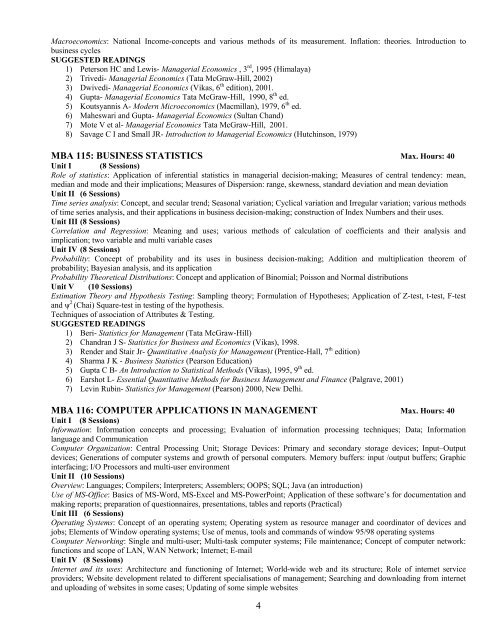
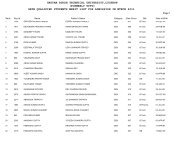
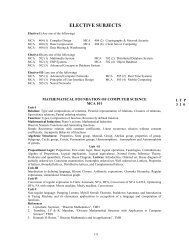

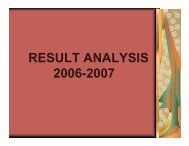

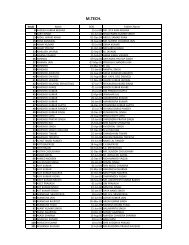

![[MODEL QUESTION PAPER] B-Tech FIRST SEMESTER ...](https://img.yumpu.com/47613205/1/190x245/model-question-paper-b-tech-first-semester-.jpg?quality=85)


